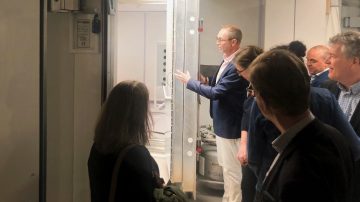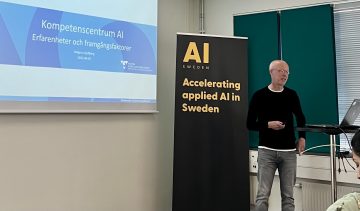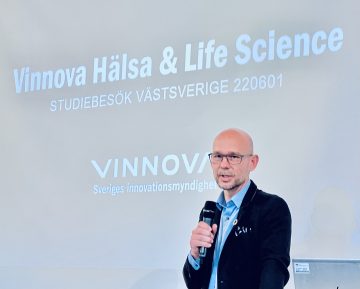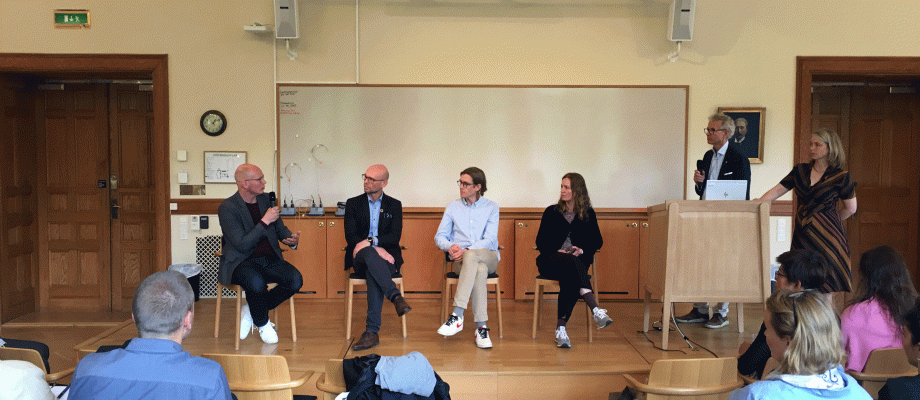INTERACTION. Life science and collaboration among the medical system, academia, and the private sector was the main theme when Vinnova, Sweden’s innovation agency, visited Gothenburg, Sahlgrenska University Hospital, and other places during the week.
“My impression after the visit is that the whole region has a culture of innovation and collaboration, which is so important. Innovation needs to come from within, and the management here also seems to be very involved in this work,” says Caroline Ekstrand, program manager at Vinnova.
She is part of Vinnova’s health team that visited Sahlgrenska University Hospital, where they learned about several examples of work in life science and innovation. A tour of the Imaging and Intervention Center showcased radiology along with the newly inaugurated SahlBEC Lab for medical technology research in a clinical environment.
 In the center, research in a wide range of areas occurs behind heavy doors in a double-shielded space to exclude radio waves and magnetic fields.
In the center, research in a wide range of areas occurs behind heavy doors in a double-shielded space to exclude radio waves and magnetic fields.
Several of the presentations made by Sahlgrenska University Hospital staff highlighted the hospital’s innovation work and extensive research.
“In radiology we have about 150 ongoing research studies right now,” said John Brandberg, head of the Department of Radiology at Sahlgrenska University Hospital.
Speakers also included Hospital Director and Professor Ann-Marie Wennberg. She highlighted the well-established collaboration among the medical system, academia, and the private sector and mentioned the work with Sahlgrenska Life, which will further strengthen future research and healthcare in Gothenburg.
In addition to Sahlgrenska University Hospital, Vinnova also toured Go Co Health Innovation City, Astra Zeneca, BioVenture Hub, and Nya Regionens Hus. The innovation agency also visited Lindholmen Science Park. There, the team was introduced to PICTA, which works with prehospital innovation and development; AI Sweden; and Sahlgrenska University Hospital’s AI Competence Center.

Magnus Kjellberg, who heads the AI Competence Center, spoke about collaboration with Chalmers University of Technology, a leader in artificial intelligence. Kjellberg highlighted the importance of having a hospital management like the one at Sahlgrenska University Hospital that really understands how important AI is to achieve its mission in a country where lifestyle diseases are increasing and the population is growing older.
“This understanding is one reason that the AI Competence Center has been placed close to the top management of the organization and that lead times for making decisions are short,” Kjellberg said.
“Meetings like this, where we can meet and talk to each other, are extremely valuable,” Hanna Maurin Söderholm, program manager at Prehospital ICT Arena (PICTA), commented afterwards. “It gives us the opportunity to tell explain the benefits resulting form the funding. We are primarily working on developing and improving ambulance care that operates under very special–and often difficult–conditions that everyone may not be aware of.”
Vinnova’s visit ended with a larger meeting at the University of Gothenburg. About 50 employees from Sahlgrenska University Hospital, Chalmers University of Technology, GU Ventures, Sahlgrenska Science Park, and the University of Gothenburg heard Lars Hammarström, director of Health and Life Science at Vinnova, and his colleagues talk about the current initiatives at the agency. Hammarström related how Vinnova supports the innovation system in health and life science and how they view future developments.

“As a public agency, we need to give researchers what they need to do their jobs,” Hammarström emphasized.
Funding, international collaboration, regulatory frameworks, and other issues were discussed at a short question-and-answer session following the presentation. Vinnova’s approach to social sustainability in health issues also came up for discussion.
When he worked in the Stockholm suburb of Botkyrka, Peter Kelly, a physician and course coordinator for the Physician Led Innovation and Technology program at Sahlgrenska University Hospital, became aware of how Swedish health and medical care is based on data and studies rather than representing the population of Danderyd. He wanted to know Vinnova’s views on issues on social sustainability and what it intends to do to increase inclusion.
“This is a great challenge,” Hammarström replied. “To address these issues, we need more data, such as more knowledge about access to health care in disadvantaged areas.
“The equal right of every citizen to good health is an extremely urgent matter that Vinnova needs to consider much more,” Hammarström said.
With that, this visit to Gothenburg came to an end.
BY: SAHLGRENSKA UNIVERSITY HOSPITAL
The article was first published in Sahlgrenskaliv.











